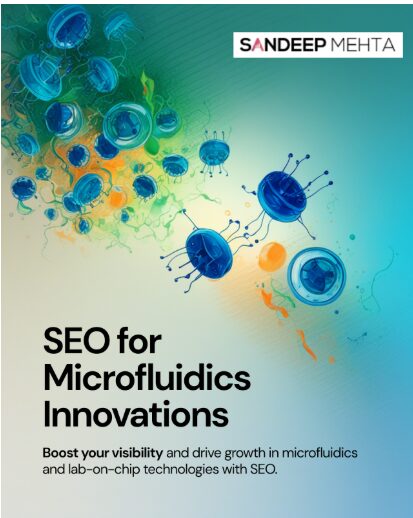SEO for microfluidics and lab-on-chip innovations is revolutionizing how scientific breakthroughs are communicated to investors, decision-makers, and researchers around the world. Forward-thinking startups and established players know that strong SEO is key to recognition and real business growth in this high-tech niche.
Tiny chips, huge impact: the driving force behind microfluidics and lab-on-chip (LOC) innovations. With faster diagnostics, lower costs, and less sample waste, these advances are rewriting the future of biology and chemistry. But most success stories never make it off the lab bench—unless digital findability keeps pace. This article explains how SEO is helping science companies break out of their silos and bring next-gen diagnostics into the global spotlight.
Niche Science Companies Turn to SEO to Reach Global Researchers
Microfluidics companies often launch in the shadows. Their work can redefine medical testing, drug discovery, or even pollution monitoring, yet websites get buried beneath generic industry listings and clunky search terms.
Why are they investing in SEO now?
- Global demand for quick, portable diagnostic tech has exploded post-pandemic.
- Researchers, labs, and procurement officers use Google, not the back pages of academic journals, to source solutions.
- Investors and collaborators often start with search—solid SEO means getting on their radar from the start.
To meet that challenge, microfluidics firms rethink their entire online strategy, from homepage keywords (“PDMS chip fabrication” or “point-of-care cartridge”) to blog updates about new applications and publications. The result? Science companies can now compete for global attention, not just conference-floor conversations.
Lab-on-Chip Startups Struggle with Technical SEO and Terminology
The promise of LOC is clear—but the words are not. Startups in this space juggle dense scientific language, strict regulatory terms, and the practical needs of searchers. Does a customer want “microfluidic immunoassay” or simply “rapid blood test chip”? Getting this right is essential to being found by both experts and end-users.
Key SEO challenges for LOC startups:
- Choosing keywords that connect engineers, clinicians, and procurement teams
- Explaining technical processes in ways algorithms—and non-specialists—can scan fast
- Balancing scientific detail with keyword density, without losing credibility
Many startups realize their resources can’t cover every topic. They concentrate on using targeted long-tail keywords such as “multiplexed detection chip for food safety,” optimize device photo alt text, and tag white papers to capture organic B2B visitors.
Search Trends Show Rising Interest in Compact Diagnostic Platforms
Search data tells a clear story: people want smarter, smaller ways to test, track, and treat. “Lab-on-chip COVID,” “portable DNA sequencer,” and “point-of-care diagnostic device” now draw steady clicks from a mix of scientists, healthcare providers, and government buyers.
Recent search signals:
- More queries for applications: water testing, infectious disease, cancer screening
- Researchers seeking open-source chip designs and manufacturing protocols
- Hospitals looking for integration with digital health platforms
This trend shifts content demand toward product demos, real-world testing results, and side-by-side comparison guides—anything that quickly communicates use and value in a fast-scrolling world.
How Content Strategy Is Evolving in the Microfluidics Space?
Today, a basic product page or a PDF specs sheet falls short of what’s required. Microfluidics and LOC brands are developing strong content ecosystems through:
- Educational blog posts explaining technology, applications, and processes
- Step-by-step guides for “how to use” and “how to clean” different platforms
- FAQ sections translating academic terms into practical benefits
- Videos and webinars showing device set-up, running tests, or troubleshooting
Case studies on breakthroughs—such as detecting E. coli in farm runoff within minutes—get top billing. Glossaries of technical terms help create entry points for new users, while newsletters keep leads coming back.
During this growth period, companies commonly bring in third-party SEO professionals. For instance, Sandeep Mehta SEO [learn more] has partnered with several lab-tech firms, helping teams unify terminology, select intent-driven keywords, and build site architectures that strengthen both user navigation and Google signals. This support gives small science firms an edge in a space where every search matters.
B2B SEO Tactics Shift for Companies Bridging Biology and Engineering
Selling LOC products requires bridging the communication gap between biologists and engineers—and then translating both into search-optimized web content. Successful firms are moving past basic product listings in favor of comprehensive B2B SEO strategies:
- Developing dedicated landing pages for hospital, academic, and industrial audiences, with specialized keywords and content for each
- Highlighting important certifications like ISO, CE, and FDA in both page titles and meta descriptions
- Offering downloadable datasheets and clear calls-to-action, such as “request a quote,” to minimize buyer friction
- Showcasing customer feedback and published results to reinforce trustworthiness and relevance
These tactics focus not just on visibility but on conversion. Each query, spanning topics like “custom microfluidic cartridge prototype” and “automated blood analysis chip supplier,” ensures a quick route to the right individual.
Microfluidics SEO: Driving Impact Beyond the Science
SEO has become the lever moving lab-on-chip innovations from niche research to global markets. Companies that explain technology in people-first language and tailor keywords to both experts and end-users will rank higher, build trust, and win more business. For microfluidics startups and scale-ups, now is the time to take findability as seriously as functionality—because the most important breakthroughs are the ones the world actually discovers.































